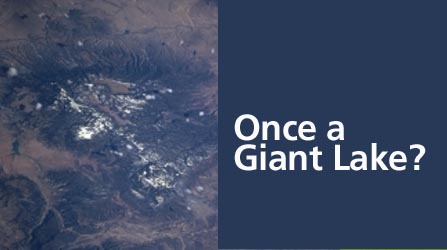|
|
 |
EES-DO
| EES-2
| EES-6
| EES-7
| EES-9
| EES-11
| EES-12
|
| FEATURE ARTICLE
> archive |
|
 Valles Caldera Will Reveal Its Long History
Julie Grey
Valles Caldera Trust
May 12, 2004
NEWS RELEASE
Ice Age Era Core Sample Will Tell the Story of the Valles Caldera—When It Was Once a Lake
Visitors driving along State Highway 4 in the Jemez Mountains have long loved the vista of the vast Valle Grande. This high mountain grassland tucked into the caldera of an ancient volcano is rich with wildlife and plant life. But not many visitors know the Valles Caldera National Preserve once held one of two or three large lakes in the area.
In mid-May and late November, scientists from the Valles Caldera National Preserve, Los Alamos National Laboratory, the United States Geological Survey and the University of New Mexico, with funding from the USGS, LANL, and the National Science Foundation will plumb the depths of the preserve to remove two core samples.
The first sample, hopefully to a depth of 100 meters (about 328 feet) or more, will be drilled beginning May 14 in the Valle Grande. A second project to extract a smaller core sample of about 30 meters (about 40 feet) is being planned for this fall in the Alamo Bog area on the west side of the preserve.
The Valle Grande core sample will trace back a history of perhaps 500,000 years, long before humans came to North America. It was an age when wooly mammoths, saber-toothed tigers, early horses, camels and antelope roamed the area. Scientists say the core may provide a glimpse into history perhaps as long as two to three ice ages ago.
A drilling rig about 20-feet tall will be positioned in an area that visitors can see from some of the State Highway 4 pull-outs overlooking the Valle Grande beginning on May 14. Active drilling should begin May 15 for a period of about a week. In that short of time, possibly 500,000 years of history, told in the accumulation of varying layers of lake deposits, will be exposed in "logs" of sediments about three to four inches in diameter and cut into five- to six-foot lengths.
Protecting the Valle Grande
Special efforts will be taken to protect the Valle Grande. Existing roadways will be used to transport the drilling rig to the location. Eventually, it will cross the Valle Grande from the main ranch road to a jeep trail. The grass and soil will be protected with special sheeting for the final leg of the journey, when the rig will be towed into place by a light pickup. Drilling mud used during the process will be stored in a large bin and removed for disposal at a quarry site on the preserve.
The core samples will be trucked to a special core storage laboratory and facility at the University of Minnesota. Project sponsors will spend an initial two weeks poring over the information they glean from the core. The cores will then be available to the general scientific community to study after a period of one year.
Clues to Lake Formation
Lakes have been present since the caldera formed 1.2 million years ago and old lake deposits are preserved in many locations within the caldera. Understanding the evolution of caldera lakes, their size and longevity is important. The caldera wall was eventually breached no later than a half million years ago by the advancing San Diego Canyon, allowing the East Fork of the Jemez River and San Antonio Creek to drain the caldera.
At times in the past, various lakes may have formed following volcanic events that formed South Mountain, San Antonio Mountain and El Cajete. It's easy for visitors to picture the oval-shaped El Cajete Meadow below Redondo Peak as a lake.
Pollen, charcoal lead to understanding of climate change
Understanding the history of the environment over a period of time helps scientists paint a good portrait of climate change over a long period of time. This long view is valuable information for predicting climate change in the future.
The team's initial study of the core samples will look for evidence of pollen that would have settled on the lake's surface and then be preserved in sedimentary layers. Information about pollen will tell researchers what kind of plant life was in the vicinity. Charcoal found in the samples will offer information on the fire cycles, lending understanding to the wet and dry cycles over the last several hundred thousand years.
Early morning visitors who see the Valle Grande shrouded in layers of mist or cloud may sometimes imagine the surface of a lake surrounded by wooded hillsides. Little do they know that their thoughts of a lake surface are very close to the truth—some 500,000 years ago.
The Valles Caldera Trust oversees the Valles Caldera National Preserve, formerly the privately owned "Baca Ranch." The 88,900 acre property is located in the Jemez Mountains in northern New Mexico. It was purchased by the federal government in 2000 under the Valles Caldera National Preservation Act. The property is known for its huge meadows, abundant wildlife, meandering streams and remarkable scenery. More information about the Preserve can be found at www.vallescaldera.gov.
> Caring for Big Foot: The Caldera Next Door, Part I
> Caring for Big Foot: The Caldera Next Door, Part II
|
|
Last updated:
5/6/04
|
|
|
EES-DO
| EES-2
| EES-6
| EES-7
| EES-9
| EES-11
| EES-12
|
|
 |
|
|


